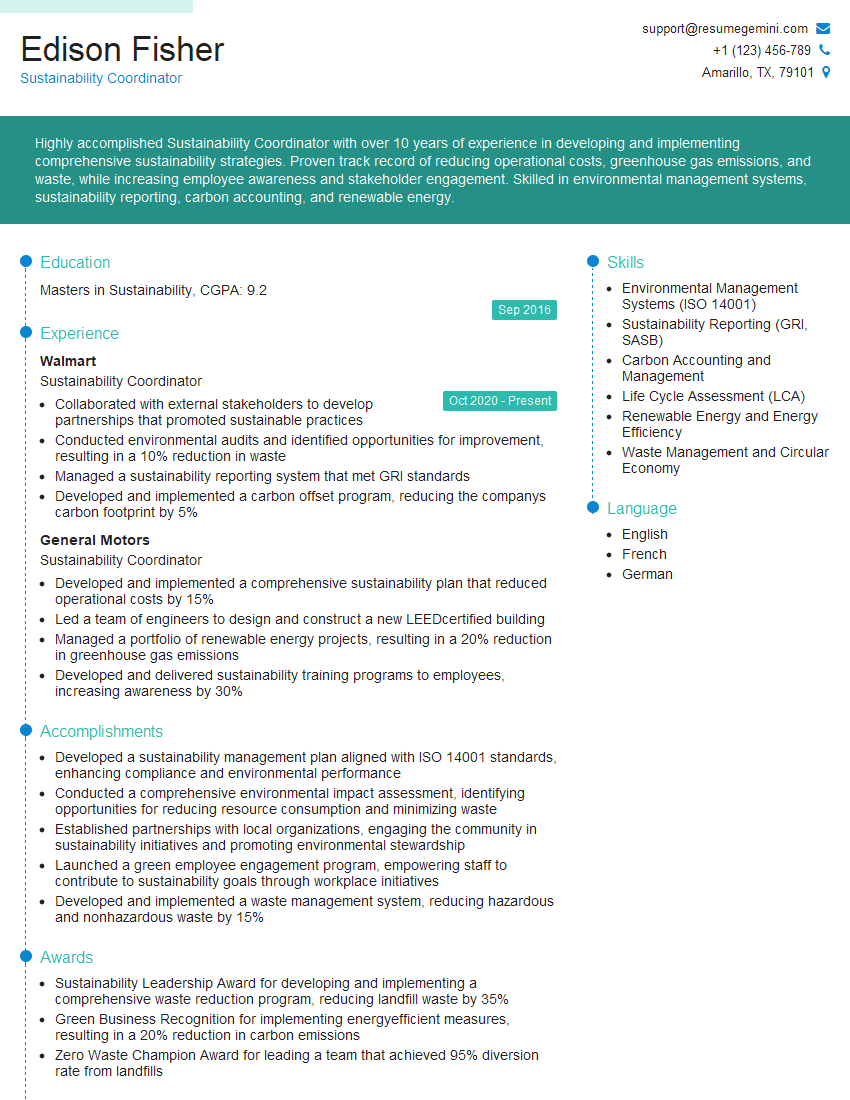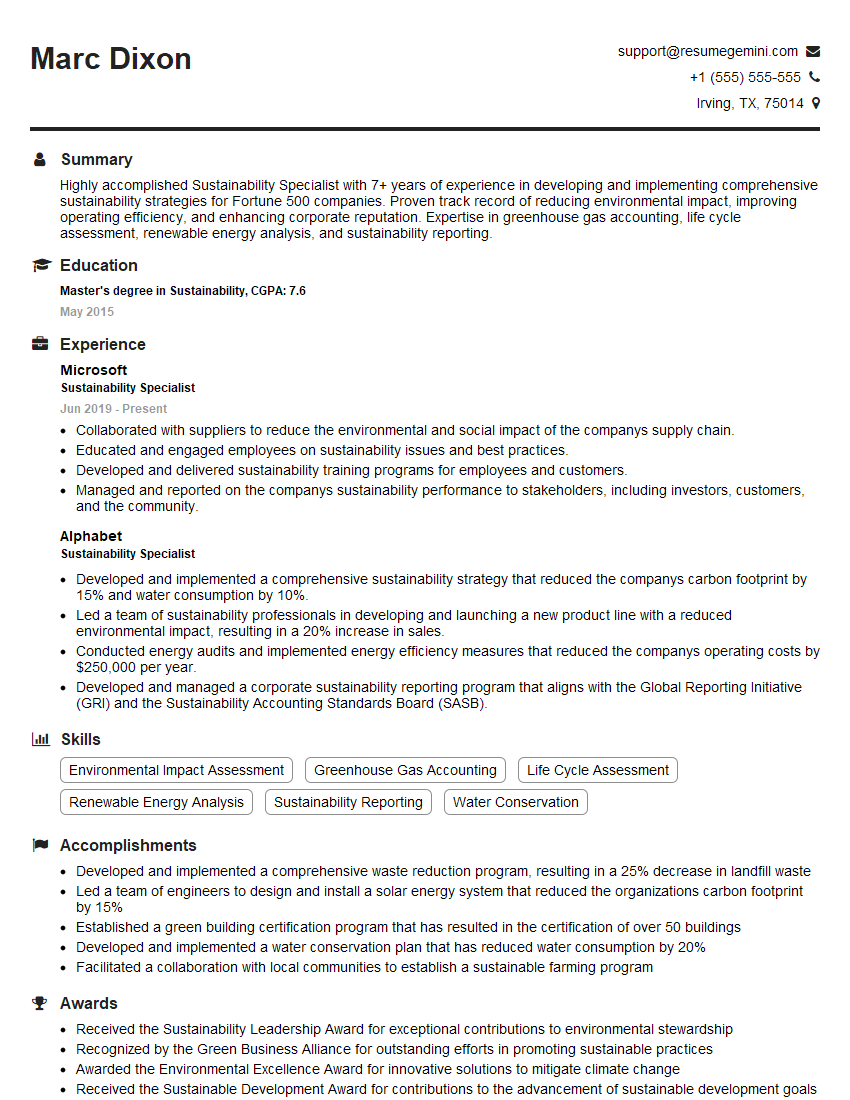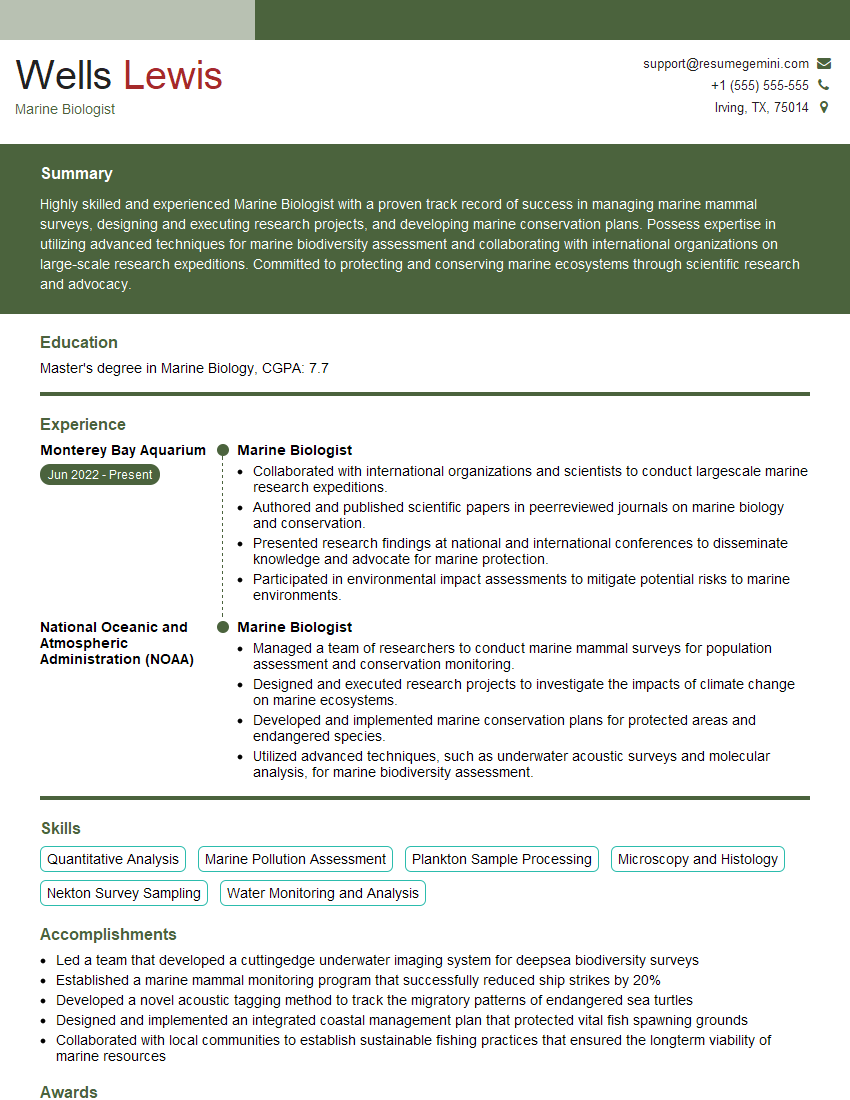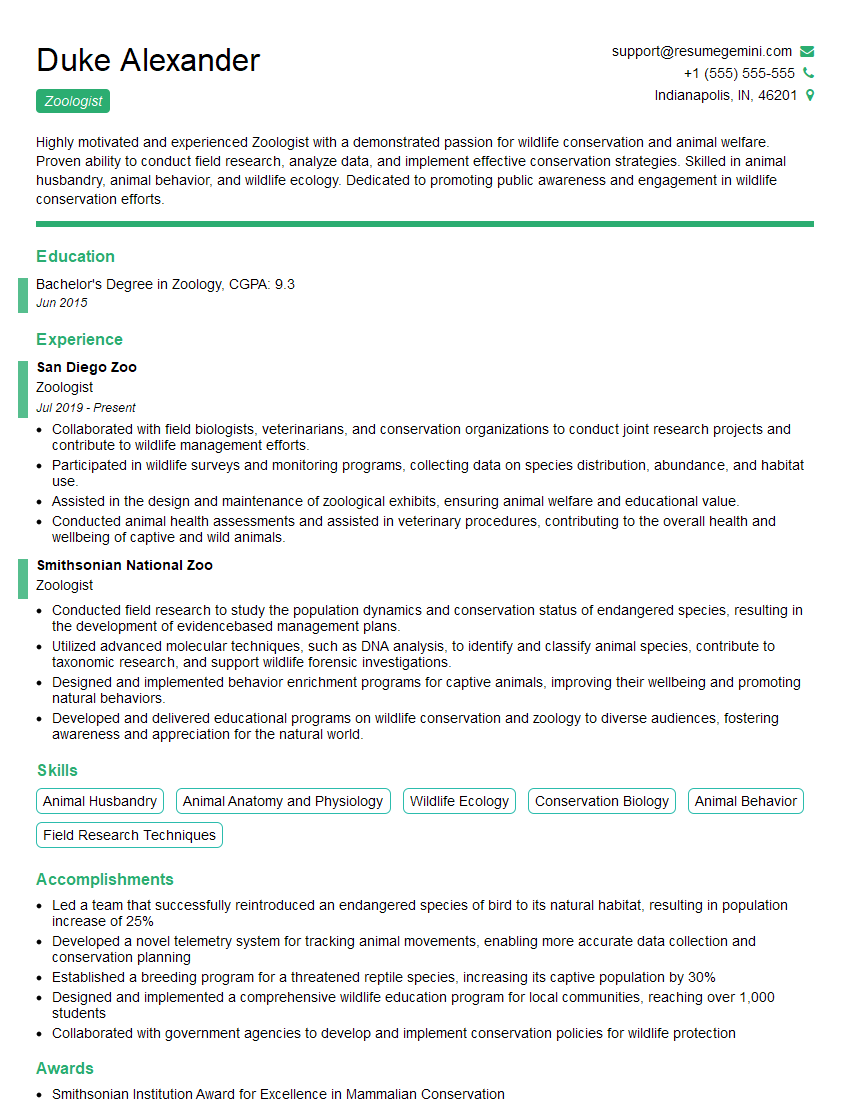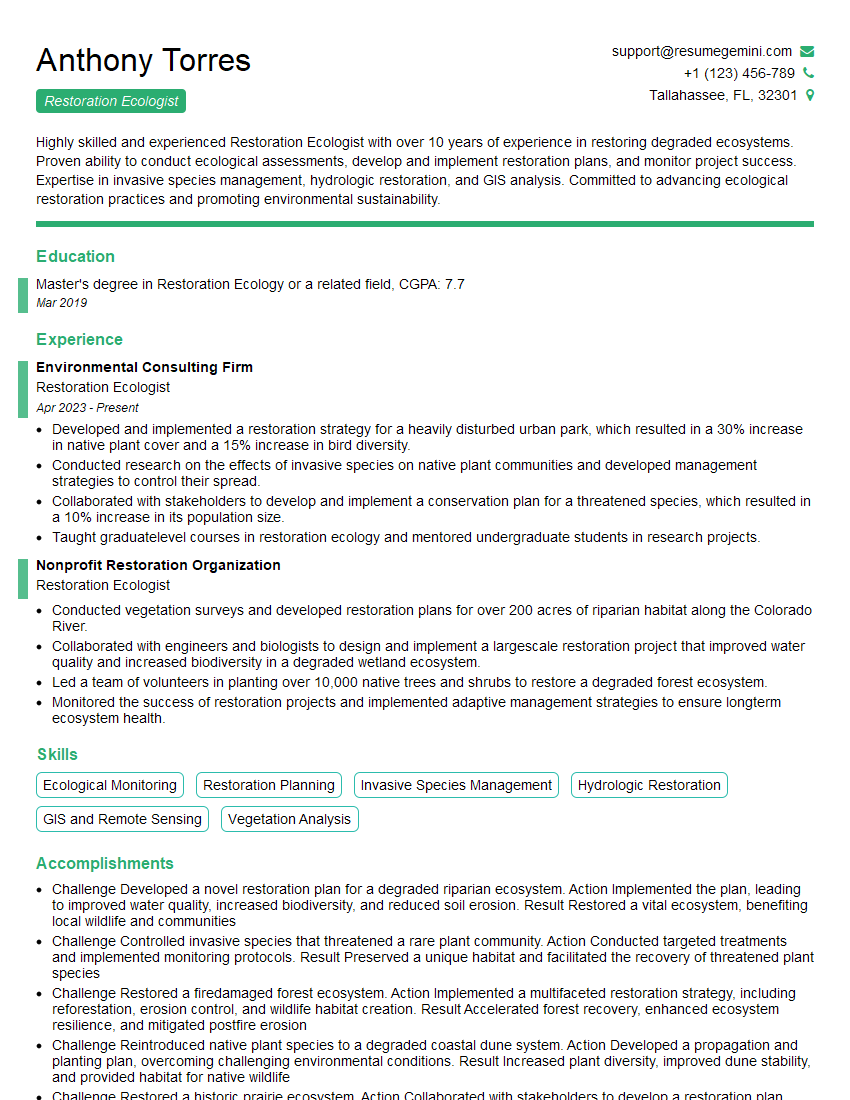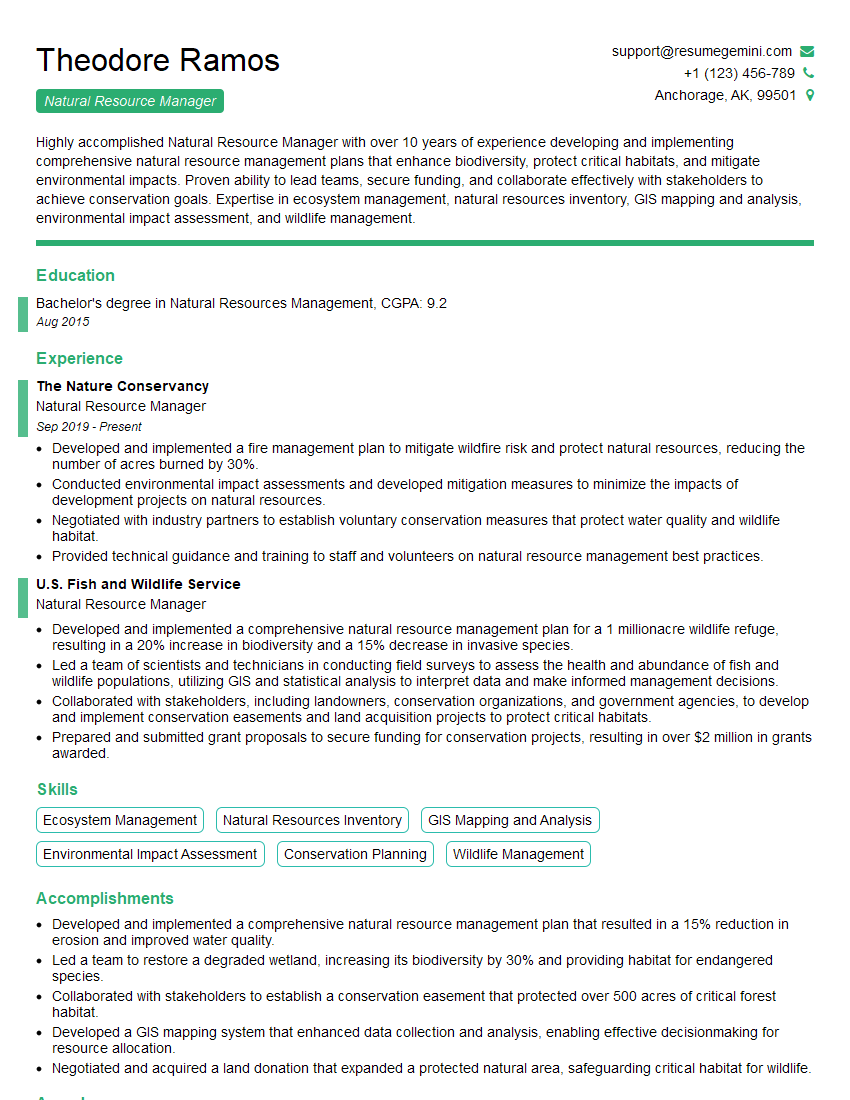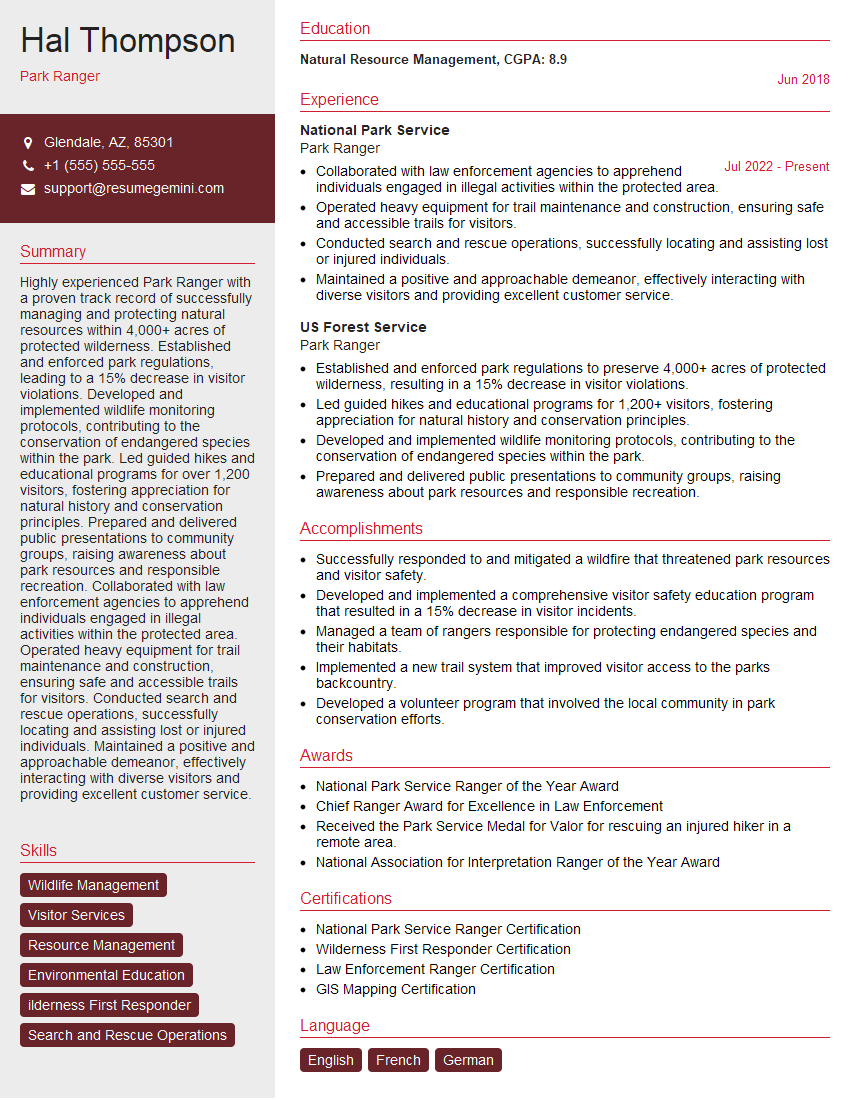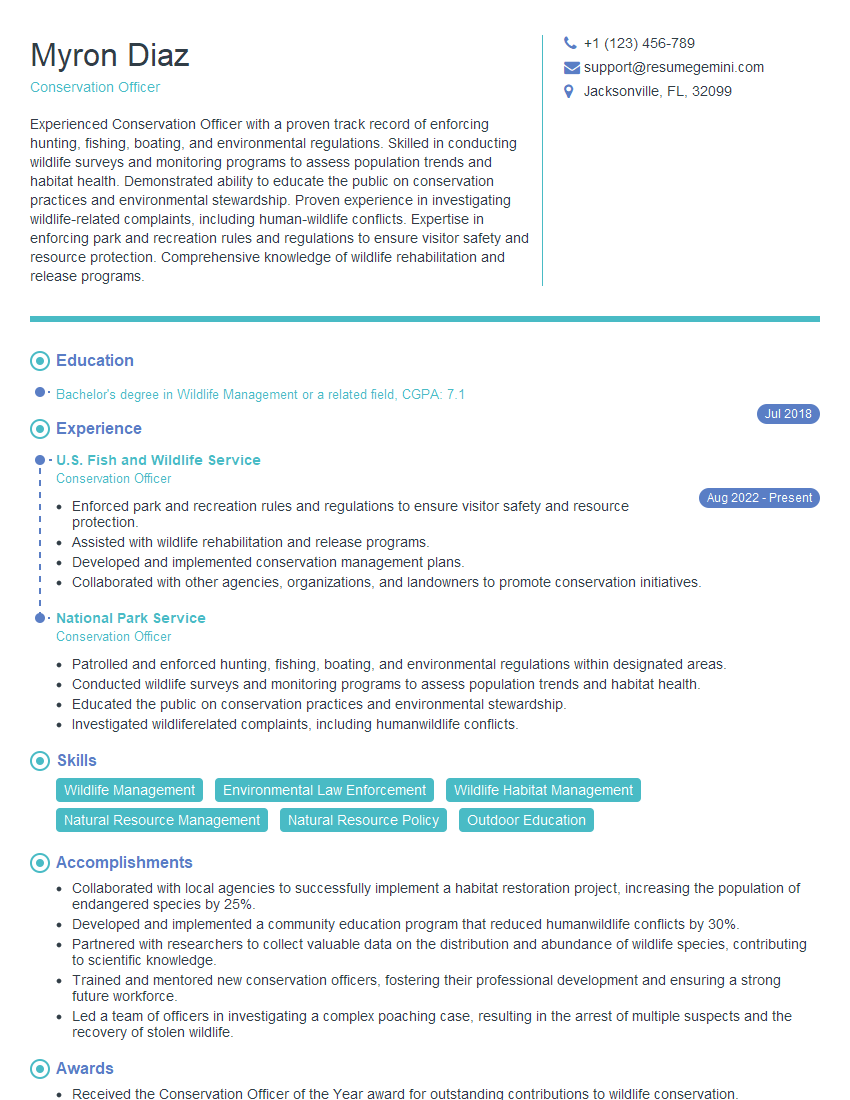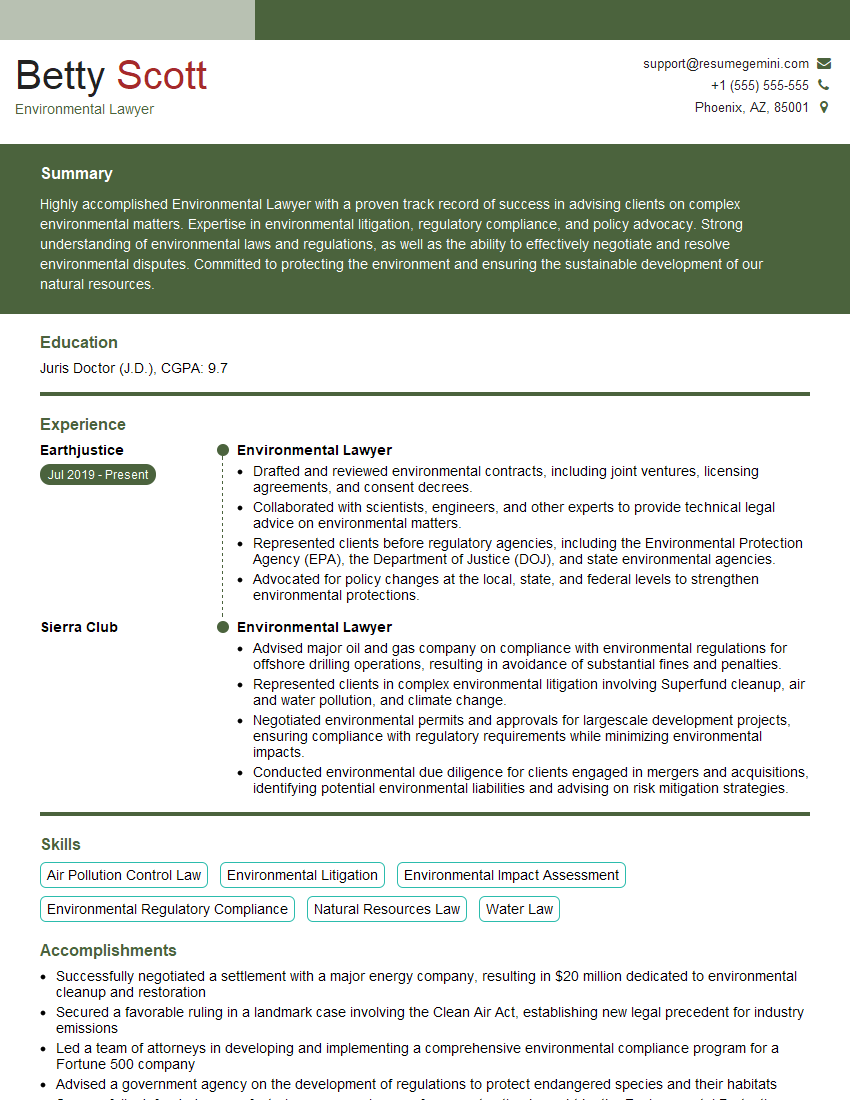The thought of an interview can be nerve-wracking, but the right preparation can make all the difference. Explore this comprehensive guide to Conservation and Ethics interview questions and gain the confidence you need to showcase your abilities and secure the role.
Questions Asked in Conservation and Ethics Interview
Q 1. Describe your understanding of the precautionary principle in conservation.
The precautionary principle in conservation is a guiding philosophy that emphasizes taking preventative action to protect the environment even in the absence of complete scientific certainty about the potential harm. It essentially states that if an action carries a significant risk of causing irreversible environmental damage, we should not proceed until that risk is adequately addressed, even if the scientific evidence isn’t conclusive.
Imagine a scenario where a new pesticide is proposed. While initial tests show no immediate harm to a specific species, there’s uncertainty about its long-term effects on the entire ecosystem. The precautionary principle would advocate for further, more comprehensive research and potentially alternative solutions before widespread use, preventing potential devastating consequences.
In practice, the precautionary principle is applied by conducting thorough risk assessments, exploring alternative solutions with lower risk, and prioritizing actions that minimize the potential for irreversible harm. It fosters proactive rather than reactive environmental management, acknowledging the complexity and often unpredictable nature of ecological systems.
Q 2. Explain the difference between intrinsic and instrumental value in environmental ethics.
Intrinsic value and instrumental value represent two fundamentally different perspectives on the worth of something in environmental ethics. Intrinsic value refers to the inherent worth of something, independent of its use or benefit to humans. Something has intrinsic value simply because it exists. Instrumental value, on the other hand, refers to the value something has because of its usefulness or benefit to humans.
Think of a pristine rainforest. It possesses intrinsic value simply by virtue of being a complex and vibrant ecosystem, even if we never use its resources. It also has instrumental value, providing ecosystem services like carbon sequestration, clean water, and potentially medicinal plants. The ethical debate often centers on balancing these two values: recognizing the intrinsic value of nature itself while also meeting human needs.
An example of a purely intrinsic value argument is the preservation of a species simply because it has a right to exist, regardless of its utility to humankind. Conversely, an argument based on instrumental value would justify conserving a species because of its role in pollination or its potential use in developing new medicines.
Q 3. How would you assess the ecological impact of a proposed development project?
Assessing the ecological impact of a proposed development project requires a systematic and multi-faceted approach. It involves identifying potential impacts, predicting their magnitude and likelihood, and evaluating the overall significance of these impacts.
- Baseline Studies: A thorough baseline study is critical, documenting the existing environmental conditions (species composition, water quality, soil characteristics, etc.) before the project begins. This provides a benchmark against which to measure changes.
- Impact Identification and Prediction: This involves identifying potential impacts – habitat loss, water pollution, noise pollution, changes in biodiversity, etc. – and predicting their likely magnitude and extent using various modeling techniques.
- Mitigation Strategies: Effective mitigation strategies are crucial. These could include minimizing habitat disturbance, employing sustainable building practices, implementing pollution control measures, and creating habitat corridors to maintain connectivity.
- Monitoring and Evaluation: Post-project monitoring is necessary to track actual impacts and ensure mitigation strategies are effective. This allows for adaptive management, adjusting strategies as needed.
For example, when assessing a highway project, we would consider impacts on wildlife migration routes, water quality from potential runoff, noise pollution affecting nearby communities, and habitat fragmentation. The assessment should propose mitigation strategies like building wildlife crossings, employing erosion control, and using noise barriers.
Q 4. What are the key ethical considerations in wildlife management?
Ethical considerations in wildlife management are complex and often involve balancing competing interests. Key ethical considerations include:
- Animal Welfare: Minimizing suffering and ensuring humane treatment of animals during capture, relocation, or culling operations is paramount.
- Species Conservation: Management decisions must be driven by scientific understanding of species needs and population dynamics to ensure their long-term viability.
- Ecosystem Integrity: Management practices should consider the impacts on the entire ecosystem and not just individual species. Maintaining biodiversity and ecosystem health are crucial.
- Fairness and Justice: Decisions should be made transparently and fairly, considering the perspectives of different stakeholders, including local communities and indigenous populations.
- Sustainability: Management practices should be ecologically sustainable, ensuring the long-term viability of wildlife populations and ecosystems.
For instance, the management of invasive species presents an ethical dilemma. While eradication might be necessary for the benefit of native biodiversity, methods used should be carefully evaluated from an animal welfare perspective. It’s crucial to find effective, humane methods, prioritizing the least harmful approaches.
Q 5. Discuss the role of biodiversity in ecosystem services.
Biodiversity, the variety of life at all levels, plays a crucial role in providing essential ecosystem services. These are the benefits humans derive from ecosystems, including:
- Provisioning services: Food, fresh water, timber, fiber, fuel, genetic resources.
- Regulating services: Climate regulation, water purification, pollination, disease control, waste decomposition.
- Supporting services: Nutrient cycling, soil formation, primary production.
- Cultural services: Recreation, tourism, aesthetic enjoyment, spiritual enrichment.
High biodiversity enhances the resilience and stability of ecosystems, making them more capable of delivering these services reliably. For example, a diverse agricultural system is more resistant to pests and diseases compared to a monoculture. Similarly, a diverse forest is better able to withstand climate change impacts. Loss of biodiversity weakens ecosystems, diminishing their capacity to provide essential services, ultimately affecting human well-being.
Q 6. Explain the concept of carrying capacity and its implications for conservation.
Carrying capacity refers to the maximum population size of a species that an environment can sustainably support given available resources and environmental conditions. This concept is crucial in conservation because exceeding carrying capacity can lead to environmental degradation, population crashes, and loss of biodiversity.
For example, a particular island might have a carrying capacity of 1000 seabirds. If the population exceeds this number, competition for food and nesting sites will increase, leading to decreased reproductive success, increased mortality, and potentially habitat destruction. Understanding carrying capacity helps in setting sustainable harvest levels for wildlife populations, determining appropriate stocking rates for livestock, and planning for human populations in relation to available resources.
In conservation, managing populations within or below carrying capacity helps maintain healthy ecosystems and prevents resource depletion. However, carrying capacity itself is not static; it can change due to factors like climate change, habitat alteration, and the presence of invasive species. Therefore, adaptive management strategies are necessary to account for these changes.
Q 7. How would you address a conflict between economic development and environmental protection?
Addressing conflicts between economic development and environmental protection requires a nuanced approach that seeks to find sustainable solutions that benefit both. It’s not a zero-sum game; genuine solutions require collaboration and innovative thinking.
- Integrated Assessment: Conduct a thorough environmental impact assessment of any development project, considering its potential consequences on biodiversity, water resources, air quality, and other factors. This should incorporate the perspectives of local communities and indigenous populations.
- Sustainable Development Principles: Apply sustainable development principles, aiming for projects that meet present needs without compromising future generations’ ability to meet their own. This often involves finding ways to decouple economic growth from environmental degradation.
- Economic Valuation of Ecosystem Services: Highlight the economic benefits of protecting environmental assets. This might include valuing the provision of clean water, carbon sequestration, or tourism opportunities. Putting a price on nature can be a powerful argument for conservation.
- Stakeholder Engagement: Foster open dialogue and collaboration between developers, environmental groups, local communities, and government agencies. Finding common ground requires transparency and understanding of competing values and concerns.
- Policy and Regulation: Effective environmental regulations, enforced consistently, play a vital role in guiding sustainable development. This includes environmental impact assessments, permitting processes, and pollution control standards.
For example, the development of renewable energy projects (solar, wind) can often be integrated with conservation goals, creating opportunities for habitat restoration or enhancing biodiversity within project areas. It’s about creating win-win scenarios, rather than viewing them as conflicting objectives.
Q 8. What are some common threats to biodiversity, and how can they be mitigated?
Biodiversity, the variety of life on Earth, faces numerous threats. These can be broadly categorized as habitat loss and degradation, climate change, pollution, invasive species, and overexploitation.
- Habitat Loss and Degradation: Deforestation, urbanization, and agricultural expansion are primary drivers, shrinking habitats and fragmenting ecosystems, isolating populations and reducing genetic diversity. Mitigation involves establishing protected areas, promoting sustainable land management practices (like agroforestry), and restoring degraded habitats.
- Climate Change: Shifting temperatures and precipitation patterns are altering ecosystems, forcing species migrations and disrupting ecological interactions. Mitigation requires global efforts to reduce greenhouse gas emissions and implement adaptation strategies, such as assisted migration for vulnerable species.
- Pollution: Air, water, and soil pollution contaminate habitats, harming organisms and disrupting ecosystem functioning. Mitigation involves stricter regulations on pollutants, promoting cleaner technologies, and implementing waste management strategies.
- Invasive Species: Non-native species can outcompete native flora and fauna, leading to biodiversity loss. Mitigation includes preventing the introduction of invasive species through biosecurity measures, early detection and rapid response programs, and control or eradication efforts.
- Overexploitation: Unsustainable harvesting of resources (e.g., overfishing, poaching) depletes populations and can lead to extinctions. Mitigation involves sustainable resource management, implementing fishing quotas, combating illegal wildlife trade, and promoting responsible consumption.
Successful mitigation often requires integrated approaches, combining conservation measures with policy changes, public awareness campaigns, and community involvement.
Q 9. Describe your experience with GIS and its application in conservation planning.
Geographic Information Systems (GIS) are invaluable tools in conservation planning. My experience spans several projects where I utilized GIS to map biodiversity hotspots, analyze habitat suitability, model species distributions, and design protected area networks. For example, in a recent project focused on preserving a critically endangered bird species, we used GIS to overlay data on habitat characteristics (elevation, vegetation type, proximity to water sources), historical sightings, and current land use to identify optimal locations for habitat restoration and creation of protected corridors.
Specifically, I’m proficient in ArcGIS and QGIS, using tools such as spatial analysis, overlay analysis, and geostatistics. We used raster and vector data to analyze the landscape, identify fragmentation, and predict future habitat loss scenarios under climate change projections. This data-driven approach enabled us to make evidence-based recommendations for conservation strategies.
Q 10. Explain the role of stakeholder engagement in conservation projects.
Stakeholder engagement is paramount for successful conservation. It involves actively involving all those who are affected by or have an interest in a conservation project. This includes local communities, landowners, government agencies, NGOs, and indigenous groups. Effective engagement requires building trust, fostering open communication, and ensuring that local knowledge and perspectives are integrated into the project design and implementation.
For instance, in a community-based conservation project in a rural area, we initiated a series of workshops and meetings to understand local land use practices and concerns. We collaboratively developed a management plan that balanced conservation goals with the community’s needs and livelihoods, thereby ensuring long-term project success and minimizing conflict.
Ignoring stakeholder concerns can lead to resistance, project failure, and even damage to the very ecosystems we aim to protect.
Q 11. How do you prioritize conservation efforts when resources are limited?
Prioritizing conservation efforts with limited resources requires a strategic approach. I use a framework that considers several factors:
- Biodiversity Value: Prioritizing species or ecosystems with high levels of endemism (species found nowhere else), high species richness, or key ecological roles. For example, protecting a rainforest with a high number of endangered species would take precedence over a less biodiverse area.
- Threat Level: Focusing on species or ecosystems facing imminent threats of extinction or habitat loss. A species on the brink of extinction would be a higher priority than one with a stable population.
- Cost-Effectiveness: Choosing interventions that yield the highest conservation return for the investment. Protecting a large area might be more expensive than targeted interventions in smaller, critical habitats.
- Feasibility: Assessing the practical and political feasibility of different options. A project with strong community support and government backing is more likely to succeed.
- Synergistic Effects: Considering actions that provide multiple benefits. For instance, protecting a watershed can benefit both aquatic and terrestrial biodiversity.
This multi-criteria decision-making process uses a weighted scoring system, balancing the relative importance of each factor based on specific project goals and available resources.
Q 12. Describe a successful conservation project you’ve been involved in.
One successful project involved the restoration of a degraded mangrove forest. The area suffered from deforestation and pollution, leading to habitat loss for numerous species of fish, birds, and other wildlife. We implemented a multi-faceted approach: community engagement, planting native mangrove species, removing pollutants, and establishing a protected area. We partnered with local communities, providing them with alternative livelihoods to reduce dependence on forest resources. Monitoring showed a significant increase in mangrove cover, biodiversity, and fish stocks within five years. The project’s success was due to the integrated strategy, community participation, and consistent monitoring and evaluation.
Q 13. What are the ethical implications of using genetically modified organisms in conservation?
The use of genetically modified organisms (GMOs) in conservation raises several ethical considerations. Potential benefits include enhancing disease resistance, increasing reproductive success, or adapting species to changing climates. However, concerns exist about:
- Unintended consequences: The potential for GMOs to have unforeseen ecological impacts, such as disrupting natural ecosystems or creating new invasive species.
- Genetic pollution: The risk of gene flow from GMOs to wild populations, potentially reducing genetic diversity or altering species characteristics.
- Ethical considerations concerning genetic manipulation: Some argue that manipulating the genetic makeup of species is inherently unethical and disrupts the natural order.
- Lack of transparency and public engagement: Concerns exist about the lack of adequate public discussion and involvement in decisions concerning GMOs in conservation.
A robust ethical framework for using GMOs in conservation would necessitate thorough risk assessment, rigorous monitoring, public engagement, and a precautionary approach. It is crucial to prioritize transparent decision-making processes and consider potential long-term consequences.
Q 14. How would you respond to criticism of conservation efforts from a skeptical community?
Responding to criticism from a skeptical community requires empathy, respectful dialogue, and a transparent approach. I would begin by acknowledging their concerns and demonstrating a willingness to listen and engage in open discussion. I would strive to use clear, non-technical language to explain the scientific basis for conservation efforts, highlighting the benefits for the community (e.g., improved water quality, enhanced tourism opportunities). I would also address specific concerns through evidence-based arguments and data, emphasizing the importance of collaboration and shared decision-making. If there are misconceptions, I would work to correct them with accurate information. If criticisms are valid, I would acknowledge shortcomings and adapt strategies accordingly. Ultimately, building trust and fostering collaboration is key to addressing skepticism and ensuring long-term support for conservation initiatives.
Q 15. Explain the concept of environmental justice.
Environmental justice is the fair treatment and meaningful involvement of all people regardless of race, color, national origin, or income, with respect to the development, implementation, and enforcement of environmental laws, regulations, and policies.
Essentially, it’s about ensuring that everyone has a right to a clean, healthy environment, and that no community bears a disproportionate burden of environmental hazards. Think of it like this: a wealthy suburb might easily afford to mitigate pollution from a nearby factory, while a low-income neighborhood might lack the resources to even protest its presence, leading to unequal exposure to harmful pollutants.
Examples of environmental injustice include the siting of polluting industries in predominantly minority or low-income communities, unequal access to clean water and sanitation, and the disproportionate impact of climate change on vulnerable populations. Addressing environmental injustice requires a multi-faceted approach involving policy changes, community engagement, and equitable resource allocation.
Career Expert Tips:
- Ace those interviews! Prepare effectively by reviewing the Top 50 Most Common Interview Questions on ResumeGemini.
- Navigate your job search with confidence! Explore a wide range of Career Tips on ResumeGemini. Learn about common challenges and recommendations to overcome them.
- Craft the perfect resume! Master the Art of Resume Writing with ResumeGemini’s guide. Showcase your unique qualifications and achievements effectively.
- Don’t miss out on holiday savings! Build your dream resume with ResumeGemini’s ATS optimized templates.
Q 16. What are the challenges of implementing international conservation agreements?
Implementing international conservation agreements faces numerous challenges. One major hurdle is the sovereignty of nations; countries are often reluctant to cede control over their natural resources or adopt policies that might impact their economic interests. For example, a developing nation heavily reliant on logging might resist restrictions imposed by an international agreement to protect forests.
Another challenge is enforcement. International agreements lack the same power as domestic laws. Monitoring compliance and enforcing penalties across borders is difficult and often requires significant international cooperation, which can be politically challenging. The lack of consistent monitoring and reporting mechanisms also hinders effective enforcement.
Furthermore, differing priorities and capacity among nations pose significant obstacles. Developed nations might have more resources and expertise to implement conservation measures than developing nations, creating inequalities in implementation. Finally, the complexity of global environmental problems, such as climate change, necessitates coordination among many actors and requires navigating diverse perspectives and interests.
Q 17. How can climate change mitigation and adaptation strategies be integrated into conservation planning?
Integrating climate change mitigation and adaptation strategies into conservation planning is crucial for long-term success. Mitigation focuses on reducing greenhouse gas emissions to slow climate change, while adaptation focuses on adjusting to the impacts of climate change that are already happening or are inevitable.
For example, in conservation planning, mitigation could involve protecting and restoring carbon sinks like forests and wetlands, which absorb CO2 from the atmosphere. Adaptation strategies could involve assisting species migration by creating wildlife corridors that accommodate shifting habitats or managing water resources to ensure sufficient water availability for threatened ecosystems under changing rainfall patterns.
A practical approach involves incorporating climate change projections into habitat suitability models, identifying vulnerable species and ecosystems, and developing management plans that address both mitigation and adaptation. This integrated approach ensures that conservation efforts are resilient to climate change impacts and contribute to global climate goals.
Q 18. Discuss the role of technology in conservation monitoring and enforcement.
Technology plays an increasingly important role in conservation monitoring and enforcement. Remote sensing technologies, such as satellite imagery and drones, provide crucial data on deforestation, poaching, and habitat changes. This allows for efficient large-scale monitoring of protected areas that would be impossible using traditional methods.
Example: Using satellite imagery to detect illegal logging activity in the Amazon rainforest allows for timely intervention and prosecution of offenders. Similarly, drones can monitor wildlife populations, track animal movements, and provide real-time information on poaching activities.
Furthermore, Geographic Information Systems (GIS) allow for spatial analysis of environmental data to identify critical habitats, predict species distribution under changing climate conditions, and optimize conservation strategies. Genetic analysis can help track illegal wildlife trade by identifying the origin of seized specimens.
In enforcement, technology aids in the use of DNA tracking of poached animals, improved communication networks for rapid response to conservation threats, and the development of sophisticated anti-poaching strategies.
Q 19. What are some effective strategies for communicating conservation issues to the public?
Effective communication of conservation issues to the public requires a multi-pronged approach. First, framing the message is critical; connecting conservation to human well-being – such as clean air and water, food security, and economic opportunities – makes the issue more relatable.
Second, utilizing diverse communication channels is essential. This includes traditional media (newspapers, television), social media, educational programs, and engaging storytelling. For instance, documentaries and wildlife photography can be powerful tools to raise awareness and create emotional connections.
Third, targeting specific audiences with tailored messages is vital. Young people might respond to social media campaigns, while older audiences may be more receptive to community events. Finally, highlighting success stories and empowering individuals to take action, however small, can foster a sense of hope and encourage engagement. For example, encouraging individuals to reduce their carbon footprint or support sustainable businesses can make them feel part of the solution.
Q 20. How do you evaluate the success of a conservation program?
Evaluating the success of a conservation program requires a comprehensive approach that goes beyond simple anecdotal evidence. It involves establishing clear objectives and measurable indicators at the outset of the project.
This could involve tracking changes in the population size of target species, habitat area, or levels of pollution. Quantitative data should be gathered using robust monitoring methods, and analysis of this data should be carried out using appropriate statistical techniques to understand the significance of any changes observed.
Qualitative data, such as community perceptions and stakeholder involvement, should also be considered, especially when understanding the broader social and economic impacts of a conservation project. A successful conservation program will not only achieve its ecological objectives but also demonstrate positive social and economic outcomes. Regular review and adaptive management is also essential for improving program effectiveness over time.
Q 21. What are the ethical considerations of wildlife tourism?
Wildlife tourism presents both opportunities and ethical challenges. The positive side is that it can generate revenue for conservation efforts, raise awareness, and provide incentives for local communities to protect wildlife and their habitats. However, several ethical considerations must be addressed.
One key concern is the welfare of animals. Activities like elephant riding or keeping animals in captivity for tourist interaction can cause significant stress and suffering. The potential for habitat disturbance from excessive tourist presence also poses a threat to fragile ecosystems. Ensuring that tourism activities are sustainable and do not compromise the long-term viability of wildlife populations is essential.
Furthermore, fair distribution of benefits generated by wildlife tourism between local communities and conservation organizations is crucial. It’s important to avoid a scenario where only a few benefit, while local communities who live alongside wildlife receive little to no economic compensation and may even experience displacement or negative impacts.
Therefore, responsible wildlife tourism requires careful planning, strict regulations, and monitoring to mitigate these ethical concerns and ensure positive impacts for both wildlife and local communities. Certifications and sustainable practices can play a key role in guiding ethical tourism operations.
Q 22. Describe your experience with data analysis and interpretation in a conservation context.
My experience with data analysis in conservation centers on using quantitative methods to understand ecological processes and inform management decisions. For instance, in a project focusing on elephant population dynamics, I used GIS software to analyze spatial data on elephant sightings, habitat use, and human-wildlife conflict incidents. This involved cleaning and processing large datasets, performing spatial analyses like kernel density estimations to identify core areas and assess habitat fragmentation, and then interpreting these results to understand elephant movement patterns and their vulnerability to poaching. I then presented these findings, incorporating statistical significance testing, to stakeholders to inform strategies like anti-poaching patrols and habitat restoration efforts. Another example involved analyzing camera trap data to estimate species abundance and diversity, using capture-mark-recapture models to account for imperfect detection.
Data interpretation wasn’t just about the numbers; it was about understanding the broader ecological context. For instance, a decline in elephant sightings in a specific area wasn’t just a statistical trend; it required investigation into potential causes like habitat loss, poaching pressure, or changes in water availability. Integrating these statistical findings with qualitative data from interviews with local communities provided a more holistic understanding of the issue.
Q 23. Explain your understanding of protected area management.
Protected area management is the process of effectively governing and managing areas designated for biodiversity conservation. This involves a multifaceted approach encompassing planning, implementation, monitoring, and adaptive management. It’s not simply about drawing boundaries on a map; it’s about actively engaging in the sustainable stewardship of those areas. This includes managing human activities within and around the protected area, including tourism, resource extraction, and local community involvement.
- Planning: This stage involves setting clear conservation objectives, defining zoning plans (e.g., core zones for strict protection, buffer zones for sustainable use), and developing a management plan detailing actions to achieve these objectives.
- Implementation: Putting the management plan into action, which might involve habitat restoration, anti-poaching efforts, visitor management, and community engagement initiatives.
- Monitoring: Regularly assessing the effectiveness of management actions by tracking biodiversity indicators (e.g., species populations, habitat condition), human impacts, and achieving conservation targets. This might involve camera trapping, vegetation surveys, or population censuses.
- Adaptive Management: Constantly refining management strategies based on monitoring results and new scientific knowledge. It requires flexibility and willingness to adjust approaches based on what is learned.
For example, managing a national park might include regulating tourism to prevent habitat damage, working with local communities to develop sustainable livelihoods that don’t rely on exploiting park resources, and implementing measures to control invasive species.
Q 24. How would you address illegal wildlife trade in your region?
Addressing illegal wildlife trade requires a multi-pronged strategy. In my region, I would focus on a combination of law enforcement, community engagement, and market-based solutions. Simply focusing on arrests won’t solve the problem; it requires addressing the root causes.
- Strengthening Law Enforcement: This involves improved capacity building for law enforcement agencies, including training, equipment, and improved coordination between different agencies. Targeting both poachers and traffickers at all levels of the supply chain is crucial.
- Community Engagement: Engaging local communities is essential. Poverty and lack of alternative livelihoods often drive people to participate in illegal wildlife trade. Providing alternative income opportunities, education programs, and empowering local communities to actively participate in conservation efforts can significantly reduce pressure on wildlife.
- Market-Based Solutions: Reducing demand is crucial. This involves public awareness campaigns to educate consumers about the impacts of purchasing illegal wildlife products. Supporting sustainable alternatives that don’t rely on unsustainable harvesting can help.
- International Collaboration: Illegal wildlife trade is transnational. Collaborating with regional and international partners to share information, coordinate enforcement efforts, and harmonize legislation is critical.
For example, we might work with local communities to develop eco-tourism initiatives, providing them with economic benefits linked to wildlife conservation. Simultaneously, we’d enhance border control measures to intercept trafficking routes and work with international organizations to combat online wildlife product sales.
Q 25. What are some innovative approaches to conservation funding?
Securing funding for conservation is a constant challenge. Innovative approaches are essential. We’re moving beyond traditional government grants and exploring diverse funding streams:
- Impact Investing: Attracting private investors who seek both financial returns and positive environmental impact. This requires demonstrating clear conservation outcomes and measurable results to investors.
- Crowdfunding: Leveraging online platforms to raise funds from a large number of individuals, particularly effective for smaller-scale projects or raising awareness.
- Conservation Finance Mechanisms: Utilizing innovative financial tools such as debt-for-nature swaps or payments for ecosystem services (PES), where landowners are compensated for providing ecological services like carbon sequestration or water purification.
- Corporate Social Responsibility (CSR): Engaging corporations to invest in conservation projects as part of their CSR initiatives, aligning their brand with conservation values.
- Philanthropic Funding: Seeking grants from foundations and individual donors who are passionate about conservation.
For example, a PES scheme might pay farmers to maintain forest buffers along rivers, improving water quality and providing habitat for wildlife, while a crowdfunding campaign might support a community-based conservation initiative.
Q 26. Describe your approach to conflict resolution in a conservation team.
Conflict resolution within a conservation team is vital for effective collaboration. My approach is based on open communication, active listening, and finding mutually beneficial solutions. I would:
- Foster Open Communication: Create a safe and respectful environment where team members feel comfortable expressing their views and concerns without fear of reprisal.
- Active Listening: Truly listen to understand each person’s perspective, acknowledging their feelings and concerns. Avoid interrupting or judging.
- Mediation: If conflicts arise, I would act as a neutral mediator, helping the conflicting parties to identify the root causes of the disagreement and work towards a solution collaboratively.
- Focus on Shared Goals: Remind the team of the common conservation objectives, emphasizing how resolving the conflict will contribute to achieving those goals.
- Facilitate Compromise: Encourage team members to find a compromise that addresses everyone’s needs and concerns, even if it means making concessions.
For example, if disagreements arise over project priorities, I’d facilitate a team discussion to clearly define objectives, weigh the pros and cons of different approaches, and collaboratively develop a prioritized action plan. The key is to focus on the problem, not on blaming individuals.
Q 27. What are the ethical considerations of rewilding projects?
Rewilding projects, while aiming to restore ecosystems, raise several ethical considerations:
- Indigenous Rights: Rewilding initiatives can sometimes displace or negatively impact indigenous communities who have traditional land rights and customary practices tied to the land. Free, prior, and informed consent (FPIC) from these communities is paramount.
- Animal Welfare: Introducing or reintroducing species may have unforeseen consequences for the animals themselves or for existing species. Careful consideration of animal welfare, potential risks, and monitoring are crucial.
- Ecosystem Integrity: Rewilding needs to consider the overall ecological context. Introducing a species might not only benefit the targeted species but also have unintended impacts on other species and ecosystem processes.
- Uncertainty and Risk: Rewilding involves inherent uncertainties about the outcome. A thorough assessment of risks and potential negative impacts is needed before implementation.
- Resource Allocation: Rewilding can be expensive. Ethical considerations arise around the allocation of resources, ensuring that funding is used effectively and equitably.
For example, a rewilding project involving the reintroduction of wolves might necessitate careful consideration of potential impacts on livestock farming communities, requiring collaborative strategies to mitigate potential conflict and ensure the project benefits all stakeholders.
Q 28. How would you assess the effectiveness of different conservation strategies?
Assessing the effectiveness of conservation strategies requires a robust monitoring and evaluation framework. It’s not enough to simply implement a strategy; you must measure its impact:
- Clearly Defined Objectives: Begin by establishing clear, measurable, achievable, relevant, and time-bound (SMART) objectives for each conservation strategy. What specific changes do you hope to achieve?
- Baseline Data: Gather baseline data on key indicators before implementing the strategy. This provides a benchmark against which to measure future changes.
- Monitoring Indicators: Select appropriate indicators that reflect the impact of the strategy on biodiversity, ecosystem processes, or human well-being. These might involve species population counts, habitat quality assessments, or socio-economic surveys.
- Data Collection Methods: Employ reliable and consistent data collection methods, ensuring data quality and accuracy. This may involve camera trapping, remote sensing, field surveys, or interviews.
- Data Analysis and Interpretation: Analyze the collected data to assess whether the strategy is achieving its objectives. Statistical methods can help determine the significance of observed changes.
- Adaptive Management: Use the monitoring and evaluation results to adapt and improve the strategy. Conservation is an iterative process, and adjustments are often necessary.
For example, to assess the effectiveness of a habitat restoration project, we would monitor changes in plant diversity, soil health, and the abundance of indicator species over time, comparing these changes with baseline data and using statistical analyses to determine the significance of the observed improvements.
Key Topics to Learn for Your Conservation and Ethics Interview
- Conservation Biology Principles: Understand core concepts like biodiversity, habitat loss, ecosystem services, and population dynamics. Consider how these principles inform conservation strategies.
- Ethical Frameworks in Conservation: Explore different ethical perspectives on environmental issues (e.g., anthropocentrism, biocentrism, ecocentrism). Be prepared to discuss the implications of these perspectives on decision-making.
- Protected Area Management: Learn about the establishment, management, and challenges of protected areas. This includes considerations of community involvement, sustainable tourism, and conflict resolution.
- Wildlife Conservation and Management: Familiarize yourself with techniques for wildlife population monitoring, habitat restoration, and managing human-wildlife conflict. Be ready to discuss case studies.
- Environmental Policy and Legislation: Understand the legal and policy frameworks relevant to conservation, including international treaties and national regulations. Consider the role of advocacy and policy influence.
- Climate Change and Conservation: Discuss the impacts of climate change on biodiversity and ecosystems. Explore adaptation and mitigation strategies in conservation planning.
- Sustainability and Conservation: Understand the principles of sustainable development and their application to conservation practices. Be prepared to discuss the intersection of economic, social, and environmental considerations.
- Problem-Solving and Decision-Making in Conservation: Practice applying your knowledge to real-world scenarios. Develop your ability to analyze complex conservation challenges and propose effective solutions.
Next Steps: Unlock Your Conservation Career
Mastering Conservation and Ethics is crucial for career advancement in this vital field. A strong understanding of these principles demonstrates your commitment and expertise to potential employers. To significantly enhance your job prospects, creating an ATS-friendly resume is essential. This ensures your qualifications are effectively communicated to hiring managers and applicant tracking systems.
We highly recommend using ResumeGemini to build a professional and impactful resume. ResumeGemini provides the tools and resources to craft a compelling narrative that showcases your skills and experience. They offer examples of resumes tailored to Conservation and Ethics roles, helping you create a document that stands out from the competition.
Explore more articles
Users Rating of Our Blogs
Share Your Experience
We value your feedback! Please rate our content and share your thoughts (optional).
What Readers Say About Our Blog
This was kind of a unique content I found around the specialized skills. Very helpful questions and good detailed answers.
Very Helpful blog, thank you Interviewgemini team.
